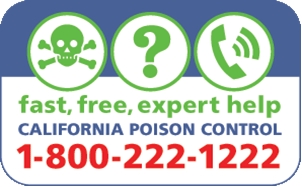![A child reaching for a pesticide stored in a common drinking container. [M.L.Poe] A child reaching for a pesticide stored in a common drinking container. [M.L.Poe]](http://ucanr.edu/blogs/UCIPMurbanpests/blogfiles/42427.jpg)
Both agricultural and household pesticides can poison people if they are not properly handled. In agriculture, poisoning most often results from pesticide mixing and loading, and the most harm occurs due to spills, splashes and equipment failure. In the home, many pesticide poisoning incidents involve children swallowing pesticides, including garden products, disinfectant cleaners, or other chemicals used to control pest organisms.
One of the most important things you can do to prevent pesticide poisoning is to follow the instructions on the label. Labels address critical information about how to use a pesticide safely, including the kind of personal protective equipment (PPE) you should wear to prevent overexposure, how much of the product to apply, the minimum time you must wait to enter the area after applying the pesticide (the restricted entry interval), and the minimum time that must pass between application and harvest (preharvest interval).
![Reading pesticide labels. [M.L.Poe] Reading pesticide labels. [M.L.Poe]](http://ucanr.edu/blogs/UCIPMurbanpests/blogfiles/42485.jpg)
If you apply pesticides in or around your home, be sure to store them properly and keep them out of the reach of children. Keep in mind that even mothballs may look like candy to very young children. It is illegal and unsafe to store pesticides in food or drink containers, which can easily fool people into consuming them and being poisoned. According to the California Department of Pesticide Regulation, these mistakes caused 62 incidents of child poisoning from pesticide ingestion in California in 2014,and 47 of those cases involved children under six years of age.
Anyone who handles pesticides can learn more about how to prevent pesticide health hazards and poisoning by reading the new edition of UC IPM's book The Safe and Effective Use of Pesticides, which was published in 2016. This publication contains a wealth of information about pesticide safety and hazard prevention.You can also sign up for mobile phone safety tips with the California Poison Control Line,or visit the National Pesticide Information Center website to stay informed about these issues.
You can also find a variety of other sources of pesticide information for both home users and professional pesticide applicators on the UC IPM website: http://ipm.ucanr.edu/GENERAL/pesticides.html.
Update 5/26/2017:
|
Clarification: When handling or applying pesticides, do so in accordance with all the label instructions and state and local regulations. In California, regulations often require additional precautions that may not be stated on the pesticide label, such as the use of chemical-resistant gloves, protective eyewear that shields the brow and temple area, and other equipment. This equipment is required to be worn during pesticide handling with few exceptions (consult the Code of California Regulations, section 6738, for more information). The tips described in this blog post are not an exhaustive list of safety measures that prevent pesticide poisoning. If you apply pesticides anywhere outside of the home and garden, or if you work in areas where pesticides are applied, you must also comply with the annual training and certification requirements listed in CCR 6724 and 6764 (links below). Pesticide handler and fieldworker training helps prevent pesticide hazards and poisoning. This blog post cannot be used as a substitute for required training. http://www.cdpr.ca.gov/docs/legbills/calcode/030302.htm#a6738http://www.cdpr.ca.gov/docs/legbills/calcode/030302.htm#a6724http://www.cdpr.ca.gov/docs/legbills/calcode/030303.htm#a6764
|
